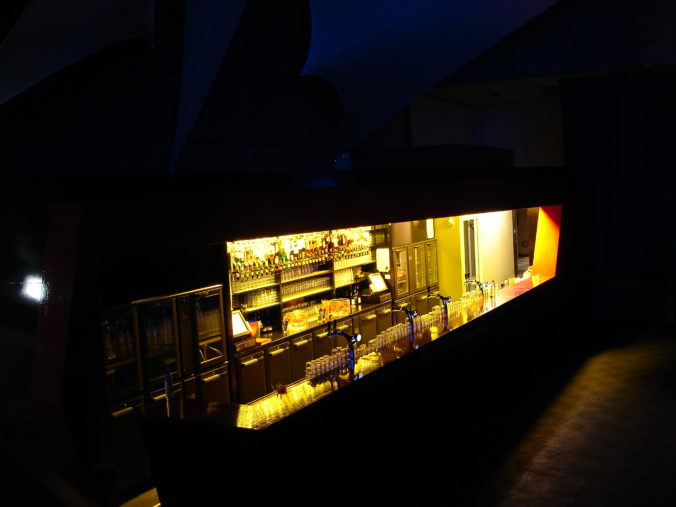“Effenaar Bar” by allert is licensed under CC BY-NC 2.0
My original metaphor for curriculum gives the presence of the machinery of learning, such as the bar itself being a chain of bars throughout the country representing the same basic concept replicated over and over again. However, my metaphor has become more complex because I noticed Ted Aoki and Ralph Tyler sitting at the bar and had a conversation with them.
Now the new version:
To me curriculum is a game of darts in the bar, where success is not always hitting the dartboard but with the game itself.
Aoki would tell us that curriculum shouldn’t always be planned but also be lived (1993). If one paid close enough attention you would notice the dart hit the poster next to the dart board that showed Jasper National Park. Although the learners are still playing darts, the conversation about the park, how bird feather was found, and how it looks similar but different to the feathered fins on the dart has already added personal meaning and depth to the game. I always enjoyed having these conversations with students that would take me away from the dart board, but never thought of how important those moments are, and how they are described as “the lived curriculum” by Aoki. I feel more comfortable in giving students time to explore the lived curriculum, and have the ammunition in applying a theoretical framework in justifying my actions.
I also find Ralph Tyler sitting at the bar. Who knew he was the one who gave the basic blueprints as to how the bar could be run as efficiently as possible! However, the blueprints are quite general, and it doesn’t necessarily mean that a bar has to be built to play darts, or that darts has to be the game. I feel Tyler’s principles on curriculum development and instruction (1949) are a logical set of principles that can be universally understood. However, this is my own anthropocentric view, and must understand that I am a product of the system itself, and my thoughts on curriculum, and my thoughts on how I process information are distinctly of Tyler’s doing.
Reflecting upon the poster of lacrosse on the wall, I realize that post-humanism may have a place in education and that of decolonizing education. The movement of post-humanism is overall a challenging process for me to understand, as I don’t have an anchor to start from. Being a human, it is natural to make connections from myself to everything around me. However, from my interpretation those connections are ones that have already been explored by First Nations people throughout the globe, who interpret their world with an alternative perspective and have thought less of humans that conquer all and more to the inter-connectedness between all matter in space surrounding them. For Aoki, this lens is already part of the lived curriculum, and the story itself, even in a post-humanist perspective, is part of the curriculum. Considering post-humanism in curriculum, I think the first step in self reflection is how little I know of the subject, and how moving forward with post-humanism is itself a big (D)iscourse in curriculum.
Going back to the game of darts we notice lots of commotion in the room. Everyone is standing two meters apart with the bartenders, servers and bouncers all talking about the dart video game. The bar has lost all of its patrons, as everyone either connected synchronously or asynchronously with the game through this bar.
Here emerges Marshall McLuhan (1988), and he asks us to question the dart video game as to what it enhances for the players, what does the game make obsolete that was there before when the players were in the bar, how does the game retrieve skills that were taught or lost before, and what will happen if players just stick to playing the dart video game without ever stepping foot back into the bar? No one could answer McLuhan’s questions, as the online environment had hastily been put into place. In addition, all the servers are trying to teach the video game remotely and the bouncers are continuously putting new rules on which console to use. As well, the servers are telling the players that certain buttons can’t be pressed on their controllers at home and are asking players to put tape of them as prescribed by the bouncers.
Just then, Vgotsky just walks into the room. His footsteps shake the wooden planks that vibrate throughout the building. Vgotsky takes a look around and only sees bartenders, servers, and bouncers. He asks how can you run a bar when all of your patrons are playing video games online and aren’t talking to each other? How are they going to become better players when they have no one to practice with? Vgotsky explains that students build their cognitive development from their social interactions (1978).
From the chaos one thing is clear, a loss of human connection between each other and a need in setting up guidelines and expectations for learner-to-learner communication. Over the last three weeks I have been talking to the patrons in the bar and reading the books which have been past down. Maybe the bar will be filled in September, but in the meantime it is better to be proactive and make a change if we are back to dartboard video games.
References:
Aoki, T. T. (1993). Legitimating lived curriculum: Towards a curricular landscape of multiplicity. Journal of Curriculum and Supervision, 8(3), 255-268.
McLuhan, Marshall and Eric McLuhan. 1988. Laws of Media: The New Science. University of Toronto Press.
Moore, M. G. (1989). Three types of interaction. The American Journal of Distance Education, 3(2), 1-6.
University of Chicago, & Tyler, R. W. (1949). Basic principles of curriculum and instruction: Syllabus for education 305.
Vygotsky, L., & Cole, M. (1978). Mind in society. Harvard University Press.




Recent Comments